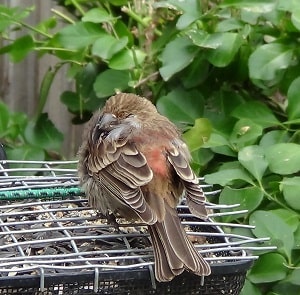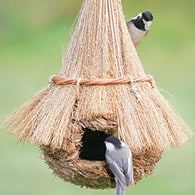Surviving Winter Nights: The Secret of Where Birds Sleep
Ever wonder where birds sleep? Especially on cold winter nights? Most birdwatchers ask this question or the other, "Do birds sleep at all?"
Well, there's no single answer as to where birds sleep as each species has various places and techniques to stay warm and sleep through a cold winter night.
All birds do sleep but not always in common ways. Read on to learn more about these places and techniques.

Two winters ago member Glenn Geyer found two dead bluebirds inside one of his 15 nestboxes in Union, Missouri.
Assuming they had frozen to death, he took the boxes down for the rest of the winter to prevent future mishaps.
birdfeeding.org turned to wildlife biologist Scott Shalaway to find out how birds stay warm at night.
A general answer is that birds sleep anywhere they safely can stay warm. Some ducks sleep in icy water. Bobwhite sleeps on the ground.
Crows and turkeys roost in trees. Screech owls and many other cavity-nesters sleep in their favorite cavities and nest boxes.
Wherever a bird sleeps, its first line of defense against cold is its feathers.
Feathers repel water and efficiently insulate warm bodies from the much colder air.
Each feather is controlled by a group of small muscles that can raise and lower it.
By fluffing their feathers, birds create many tiny air spaces that drastically reduce heat loss (the same principle that makes down jackets so warm in winter).
On extremely cold nights, birds reduce heat loss further by burying naked body parts into their feathers.
This is why birds tuck their bills into their shoulder feathers and why many water birds often sleep with one leg held tightly up against the body.
Birds also have an amazing network of blood vessels in their feet and legs that minimizes heat loss.
Sleeping quarters also protect birds from the elements.
Songbirds such as cardinals, blue jays, and finches retire to dense thickets of vegetation.
Take a walk at dusk through such a habitat and you'll be amazed at the commotion as birds settle in for the night.
Tangles of briars, grape vines, and brambles protect birds from all but the hardest driving rains.
Even greater protection is found in evergreen refuges such as conifers and ivy-covered walls. This is a good ecological reason for every bird-friendly backyard to include some evergreens.
Some Birds Sleep in Cavities
Woodpeckers, wrens, titmice, nuthatches, and other cavity-nesting birds sleep in birdhouses or cavities much like the ones in which they nest.
In the Rocky Mountains, pygmy nuthatches sometimes roost by the dozens in large tree cavities.
Roosting cavities cannot guarantee survival, however. Sometimes, it just gets too cold, and birds freeze.
And sometimes birds at the bottom of the heap suffocate.
About 18 years ago I found four dead bluebirds in a nest box after one particularly frigid Oklahoma cold snap.
Other avian sleeping arrangements are a bit more unusual. The Bobwhite sleeps in a tight circle on the ground, all heads facing outward.
The contact enables them to conserve precious body heat, and the outward orientation allows wary eyes to detect danger in all directions.
And when there's lots of snow cover, ruffed grouse sometimes bury themselves in snowdrifts, where the snow itself insulates them from plummeting outside air temperatures.
Despite their relatively small size and lack of large amounts of body fat, birds use peculiarities of anatomy, physiology, and behavior to make it through the coldest winter nights.
Related Reading:
© birdfeeding.org.The Bird's-Eye reView - used with permission






